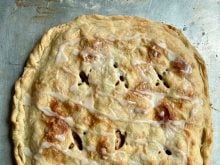Now that harvest is finally over, I have been getting things back to normal in the house. As part of my sorting activities, I was going through and organizing household hints contributed by readers.
Here are some stain removal and cleaning suggestions:
- This hint was discovered quite by accident. My husband, Gordon, asked me if I could remove an oil stain from his coveralls. He suggested using Mr. Clean, the last thing I would have tried. I had visions of a tattered pair of coveralls.
Read Also

Support needed at all levels for high-value solar projects
Farmers, rural municipalities and governments should welcome any opportunity to get involved in large-scale solar power installations, say agrivoltaics proponents.
Anyway, I figured I had nothing to lose. After all, it was Gord’s suggestion. Not only did the coveralls come out in one piece, but the stain was gone. The coveralls looked great. Not long after that, my neighbour phoned asking if I knew how to remove tough stains. So I suggested Mr. Clean. She had a similar cleaning product with the same wording, such as “contains no phosphates, chlorine bleach or ammonia.” She used it to wash her husband’s shirts with the same results – the stains were gone.
Home management hint: Put things away as soon as you’re finished with them. – W.H., Fort Saskatchewan, Alta.
- To get ink marks out of material, use hair spray and then wash it out. – Mrs. W.P., Montmartre, Sask.
- To clean fur fabric trim or plush toys, heat bran or cornmeal in the oven, rub in and leave for a couple of hours. Then brush out. Repeat if necessary. To remove grease stains from rugs and clothing, rub cream of tartar into the stain, and leave overnight. Next day, brush it out. – B.S., Manitou, Man.
The Canadian Consumer Specialty Products Association suggests the following solutions for treating different stains:
Mustard: Treat the stain with a prewash product and then launder the item using
chlorine bleach, if it is safe for the clothing, or use colour-safe bleach.
Ketchup, barbecue and spaghetti sauces: Scrape and treat with dry cleaning solution, rub with liquid detergent and scrub stain under hot water. Then wash the stain in the hottest water that is safe for the fabric.
Grass stains: Use a pretreat laundry product, and then launder the garment as soon as possible. Make sure the stain is gone before drying, because the heat of the dryer could set the stain. If the stain persists, launder the garment again using bleach that is safe for the fabric.
Ice cream: Use a pretreat laundry product and launder. If it is an old stain, let the garment soak for several hours.
Perspiration: Use a prewash stain remover or rub with a bar of soap and then launder on the hottest water that is safe for the fabric. If perspiration has changed the colour of the fabric, apply ammonia to fresh stains or white vinegar to old stains, then rinse. Stubborn stains may respond to washing with colour-safe bleach in the hottest water that is safe for the fabric. For more tips on effective laundering and cleaning, visit the Soap and Detergent Association
of Canada, www.healthycleaning
101.org.
Source: News Canada.
More hints from readers:
- To remove black scuff marks on the floor, rub them with your running shoes (wearing them, of course, so there’s no bending or stooping). – B.A., Bashaw, Alta.
- To take black scuff marks off a floor, rub with baking soda. They come off like a charm. – L.H., Edmonton.
- To take off sticky glue left from price tags and labels on glass or other things, rub with peanut butter. It works. – C.W., Penzance, Sask.
- Remove labels from plastic pill bottles, then spray on WD-40 to remove adhesive. Just wipe off with paper towel. – M.M., Cochrane, Alta.
- I save the sorbent or silica gel packets that come in the packing of some products (as in vitamin pill bottles). I put one in the fridge for an odour reducer, and put one inside a food chopper jar to absorb moisture after it’s washed to keep away mould or rust. – R.M., Oxbow, Sask.
- To clean the stains in a Thermos bottle, fill it with hot water and add denture cleaning tablets. It works like a charm. I add two tablets, and leave it overnight. – V.S., Meath Park, Sask.
- My cleaning hint is to keep a spray bottle near the sink that is filled with a mixture of bleach and water. Then when there is a stain on dishes or cups, I just spray it clean. Or I spray the sink or anywhere else that needs cleaning. – T.N., Mossbank, Sask.
(We advise that you be very careful with bleach spills or spots on the counter because they will damage the clothes you are wearing.)
- Tea and coffee stains will lift off your delicate china cups if you rub the insides of each with a damp cloth sprinkled with baking soda or salt. – J.R., Arborfield, Sask.
- When washing dishes, I put a couple of squirts of vinegar (from a pump action bottle) into the rinse water. It helps eliminate water spots and I always rinse the dishcloth and scrubber in the water when I’m done washing. It seems to keep the dishcloth from getting that dishrag smell. – S.W., Stuartburn, Man. and J.R., Arborfield, Sask.
- To unclog a drain, pour 1/2 cup (125 mL) baking soda down the drain and add one
cup (250 mL) vinegar. Cover the drain and wait a few minutes. Rinse with boiling water. – J.D., Regina.
- Keep a bottle of homemade bathroom cleaner in a spray bottle ready. Mix together until smooth: three tablespoons (45 mL) baking soda, 1/4 cup (60 mL) ammonia, and two cups (500 mL) warm water. Shake well before using. This really works. – K.M., Claresholm, Alta.
- This multipurpose cleaner works well on the floors and walls of our honey house where we extract honey. Mix together in one gallon (four L) warm water: one cup (250 mL) household ammonia, 1/2 cup (125 mL) white vinegar, and 1/4 cup (60 mL) baking soda. Store the cleaner in a clean bottle, and use as needed. And never mix chlorine bleach with ammonia or vinegar because the fumes can be poisonous. – M.L., Ashcroft, B.C. and B.S., Manitou, Man.
- When I get sour dishcloths, I soak them in pure vinegar overnight. Next morning, I scrub the cloths in vinegar, then switch to water, rinsing several times. Then I wash the cloth in a regular (hot, soapy) wash cycle. I put a dollop of bleach in my sink when washing some dishes by hand. I usually wear gloves when I do this otherwise my hands soak up too much of the bleach smell. – M.S., Central Butte, Sask.
- Scouring pads will never rust if you sprinkle a little baking soda in the bottom of the dish in which they are stored. Double the life of soap-filled scouring pads by cutting them in half. – J.R. Arborfield, Sask.
- Your glasses will dry spot free if you add a little vinegar to your dishwasher rinse cycle. – J.R. Arborfield, Sask.
- Clean copper with a mixture of one
tablespoon (15 mL) flour, one tablespoon (15 mL) salt, and one tablespoon (15 mL) vinegar. You can also polish with ketchup if you haven’t copper polish on hand. – P.B., Sundre, Alta.
- After roasting anything that splatters in the oven, put a shallow dish of ammonia and water inside immediately. Let sit overnight. In the morning, wash out with hot, soapy water to which a few drops of vinegar have been added. – P.B., Sundre, Alta.
Cookbook draw
We are planning another cookbook draw for early December. What does your family serve at seasonal celebrations like Thanksgiving, Christmas, Hanukkah or New Years? To enter the draw, share your recipes by sending them by e-mail to team@producer.com or mail to TEAM Resources, c/o The Western Producer, Box 2500, Saskatoon, Sask. S7K 2C4. The deadline for entries is Dec. 6.
Barbara Sanderson is a home economist from Rosetown, Sask., and one of four columnists comprising Team Resources. Send correspondence in care of this newspaper, Box 2500, Saskatoon, Sask., S7K 2C4 or contact them at team@
producer.com.














